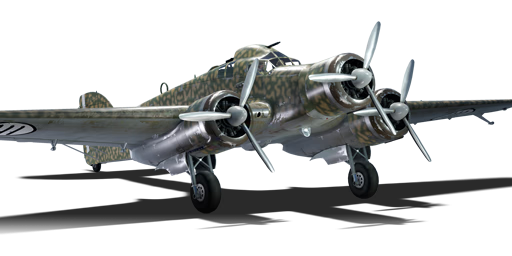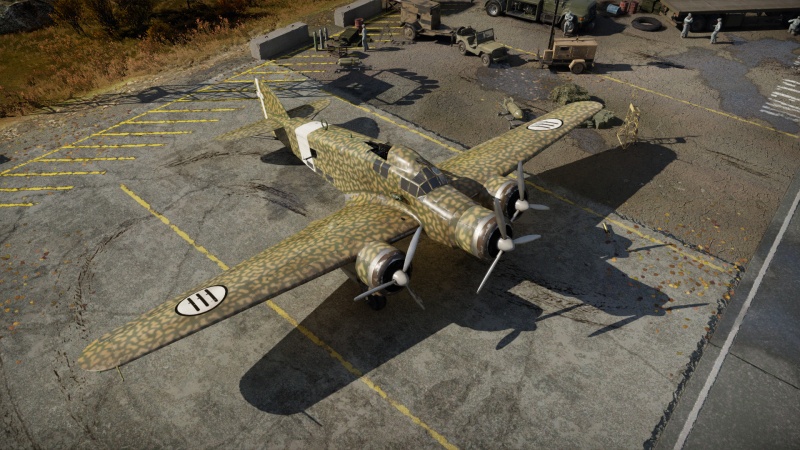Difference between revisions of "S.M.79 AS (Germany)"
(→In-game description: Reformatted) |
(→See also) |
||
| Line 198: | Line 198: | ||
== See also == | == See also == | ||
| − | ''Links to the articles on the War Thunder Wiki that you think will be useful for the reader, for example:'' | + | <!--''Links to the articles on the War Thunder Wiki that you think will be useful for the reader, for example:'' |
* ''reference to the series of the aircraft;'' | * ''reference to the series of the aircraft;'' | ||
| − | * ''links to approximate analogues of other nations and research trees.'' | + | * ''links to approximate analogues of other nations and research trees.''--> |
| + | |||
| + | ;Related development | ||
| + | *[[S.M.79 (Family)]] | ||
== External links == | == External links == | ||
Latest revision as of 14:48, 5 July 2024
| This page is about the gift German bomber S.M.79 AS (Germany). For other versions, see S.M.79 (Family). |
Contents
Description
The ▀S.M.79 Sparviero AS (1941) is a gift rank II German bomber with a battle rating of 2.3 (AB/RB/SB). It has been in the game since the start of the Open Beta Test prior to Update 1.27 in the German aviation tree. In Update 1.69 "Regia Aeronautica", the S.M.79, as well as the other Italian planes in the German tree, were moved to the new Italian tree.
General info
Flight performance
| Characteristics | Max Speed (km/h at 4,000 m) |
Max altitude (metres) |
Turn time (seconds) |
Rate of climb (metres/second) |
Take-off run (metres) | |||
|---|---|---|---|---|---|---|---|---|
| AB | RB | AB | RB | AB | RB | |||
| Stock | 458 | 444 | 9000 | 32.5 | 33.2 | 2.1 | 3.4 | 400 |
| Upgraded | 507 | 480 | 29.6 | 31.0 | 11.5 | 5.9 | ||
Details
| Features | ||||
|---|---|---|---|---|
| Combat flaps | Take-off flaps | Landing flaps | Air brakes | Arrestor gear |
| ✓ | ✓ | ✓ | X | X |
| Limits | ||||||
|---|---|---|---|---|---|---|
| Wings (km/h) | Gear (km/h) | Flaps (km/h) | Max Static G | |||
| Combat | Take-off | Landing | + | - | ||
| 530 | 300 | 313 | 298 | 220 | ~4 | ~2 |
| Optimal velocities (km/h) | |||
|---|---|---|---|
| Ailerons | Rudder | Elevators | Radiator |
| < 260 | < 270 | < 270 | > 290 |
| Compressor (RB/SB) | ||
|---|---|---|
| Setting 1 | ||
| Optimal altitude | 100% Engine power | WEP Engine power |
| 3,300 m | 2,250 hp | 3,020 hp |
Survivability and armour
- No armour plating
- No armour glazing
- Fuel tanks located in fuselage and wing roots
Modifications and economy
Armaments
Offensive armament
The S.M.79 AS (Germany) is armed with:
- 1 x 12.7 mm Breda-SAFAT machine gun, dorsal-mounted (350 rpg)
Suspended armament
The S.M.79 AS (Germany) can be outfitted with the following ordnance:
- 12 x 50 kg GP 50 bombs (600 kg total)
- 12 x 100 kg GP 100T bombs (1,200 kg total)
- 5 x 250 kg GP 250 bombs (1,250 kg total)
- 1 x 450 mm F200/450 torpedo
- 2 x 500 kg GP 500 bombs (1,000 kg total)
Defensive armament
The S.M.79 AS (Germany) is defended by:
- 1 x 12.7 mm Breda-SAFAT machine gun, dorsal turret (500 rpg)
- 1 x 12.7 mm Breda-SAFAT machine gun, ventral turret (500 rpg)
- 1 x 7.7 mm Lewis machine gun, 2 x beam turrets (485 rpg)
Usage in battles
With a significantly higher BR than the previous two Sparviero models, the 1941 Sparviero features the same bomb load-outs (but can also carry a single torpedo) and armament, with only relatively minor increases in performance. While unable to compete with the Ju 88 or the He 111 H-6 and Fw 200 C-1 Condor in terms of performance or sheer bomb-carrying capacity, respectively, the S.M.79 AS can still perform decently if played carefully.
It is very important to avoid fighters in the S.M.79, as it has a lot of defensive fire dead-zones and is not as durable as the Ju 88. If an enemy fighter is foolish enough to stay within the reach of the 12.7 mm Breda-SAFATs, they can deal a considerable amount of damage to the pursuer. However, the gunners themselves have no armour protection and can be knocked out fairly easily.
Due to the relatively light payload carried by the S.M.79, it is not particularly recommended to go base bombing, even with the max load of 5 x 250 kg bombs. It is better to dive towards ground level and destroy targets like tanks or vehicles, as this will make it harder for enemies to attack you from below, where the Sparviero has very limited defensive fire coverage. The 500 kg bombs reduce your total bombload to only 1,000 kg, but they are more forgiving of poor bomb aiming and can take out pillboxes with a single hit. Be wary of attacks from the sides, as only the weak 7.7 mm machine guns cover the flanks of the Sparviero.
Manual Engine Control
| MEC elements | ||||||
|---|---|---|---|---|---|---|
| Mixer | Pitch | Radiator | Supercharger | Turbocharger | ||
| Oil | Water | Type | ||||
| Not controllable | Controllable Not auto controlled |
Not controllable Not auto controlled |
Not controllable Not auto controlled |
Separate | Not controllable 1 gear |
Not controllable |
Pros and cons
Summarise and briefly evaluate the vehicle in terms of its characteristics and combat effectiveness. Mark its pros and cons in the bulleted list. Try not to use more than 6 points for each of the characteristics. Avoid using categorical definitions such as "bad", "good" and the like - use substitutions with softer forms such as "inadequate" and "effective".
Pros:
- Can carry a torpedo
Cons:
- Poor survivability
History
| Archive of the in-game description | |
|---|---|
|
Three-engine SIAI Savoia-Marchetti S.M.79 "Sparviero" medium torpedo bomber, issued 1941. By early 1941 the number of "Sparvieros" in the Italian Royal Air Force began to decrease. The more advanced CANT Z.1007 "Alcione", also a three-engined plane, was replacing the ageing S.M.79. However, the "Sparviero" soon had another, just as important role as the primary "workhorse" of Italian naval aviation. In March 1937, one of the S.M.79s was equipped with a special torpedo sight, and under the fuselage a left-offset suspension rack was installed for an 860 kg 450 mm torpedo. In November 1937, the plane passed all flight tests. In March 1938, a new version which carried two torpedoes was tested. This time, results were not so good, since the weight hindered the plane's controllability. Consequently, the variant accepted was the one-torpedo version. Beginning in late 1939, all S.M.79 production aircraft were fitted with torpedo mounts. The S.M.79 torpedo bombers had virtually the same design as the regular bombers. Their crew was increased by one person: a naval observation officer, who sat between radio operator and mechanic. From 1941 on, the engines were equipped first with extended tailpipes, and then with Wellington flame arresters. Arresters were also installed on the barrels of the machine guns. In 1942, the Alfa-Romeo 126RC34 engines were equipped with an ethanol injection system, which allowed a short engine output boost to 900 hp, increasing the plane's speed by 50 km/h. But this reduced the engine's life span, which was already unsatisfactory. On July 25, 1940, the first experimental torpedo squadron, containing five aircraft, was founded. It was an S.M.79 from this group that launched the first torpedo attack on the ships in the Egyptian port of Alexandria on August 15, 1940. By early 1942, the Italian torpedo bombers had become a major force to be reckoned with. By November 1942 there were 147 S.M.79 torpedo bombers in service, in nine groups. In June and August 1942, the Italians persistently attacked British convoys breaking through to Malta with moderate success, but they themselves lost about 50 S.M.79s, with experienced crews. | |
Media
- Skins
See also
- Related development
External links
| Savoia-Marchetti | |
|---|---|
| Bombers | S.M.79 serie 1 · S.M.79 serie 8 · S.M.79 AS · S.M.79 bis/T.M |
| S.81 | |
| Attackers | SM.91 · SM.92 |
| Export | S.M.79 B |
| Captured | ▀S.M.79 serie 1 · ▀S.M.79 serie 4 · ▀S.M.79 serie 8 |
| ▀S.M.79 AS · ▀S.M.79 bis/N · ▀S.M.79 bis/T.M · ▀S.M.79 B | |
| Germany bombers | |
|---|---|
| Arado | Ar 196 A-3 |
| Blohm & Voss | BV 138 C-1 · BV 238 |
| Dornier | Do 17 E-1 · Do 17 Z-2 · Do 217 E-2 · Do 217 E-4 · Do 217 K-1 · Do 217 M-1 |
| Focke-Wulf | Fw 189 A-1 · Fw 200 C-1 |
| Henschel | Hs 123 A-1 |
| Heinkel | He 111 H-3 · He 111 H-6 · He 111 H-16 · He 115 C-1 · He 177 A-3 · He 177 A-5 |
| Junkers | Ju 87 B-2 · Ju 87 R-2 · Ju 87 R-2 Libya · Ju 87 D-3 · Ju 87 D-5 · Ju 88 A-1 · Ju 88 A-4 · Ju 188 A-2 · Ju 288 C |
| Messerschmitt | Me 264 |
| Savoia-Marchetti | ▀S.M.79 serie 1 · ▀S.M.79 B · ▀S.M.79 serie 4 · ▀S.M.79 serie 8 |
| ▀S.M.79 AS · ▀S.M.79 bis/N · ▀S.M.79 bis/T.M | |
| Trophies | ▀Wellington Mk Ic |





